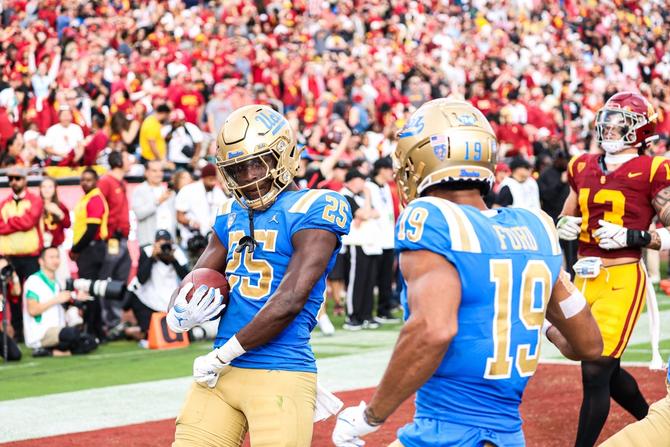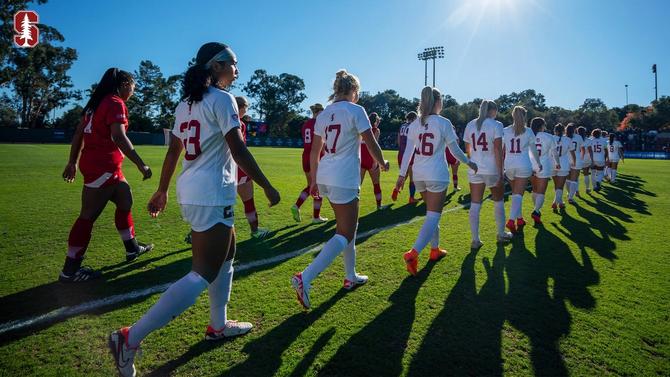The rich get richer
From The GIST College Sports (hi@thegistsports.com)

Happy Hump Day!
And welcome back to conference realignment week. On Monday, we covered the past and present, but what about the future? Today we peer into the conference crystal ball — but first, a few updates from around the NCAA.


— Stanford women’s soccer defender Nya Harrison on the Cardinal’s move to the ACC — a conference primarily based on the East Coast — following the Pac-12’s dissolution last month.
- The farthest Harrison’s squad will travel for a conference game this upcoming season? About 2,800 miles — a five-and-a-half hour flight — for back-to-back games against Wake Forest and NC State. Here’s to frequent flier miles.
🏀 The hoops world is obsessed with 17-year-old Cooper Flagg since the Duke recruit hung with the NBA’s best at Monday’s Team USA men’s basketball scrimmage. Prepare to hear the 17-year-old’s name a lot when his freshman season tips off in November.
👟 It’s officially official: Florida grad Parker Valby will become an Olympian in a few weeks. She locked in her Team USA spot in the women’s 10,000m on Monday and will be racing for gold on Friday, August 9th, at 2:55 p.m. ET.
🤸 LSU gymnast and NIL juggernaut Olivia “Livvy” Dunne is running it back for a fifth and final year with the reigning national champs, she announced on Monday. Not Dunne yet.
💸 Monday was payday for UConn men’s basketball coach Dan Hurley, who re-upped with the reigning back-to-back champs with a six-year, $50M contract — $20M less than the NBA’s LA Lakers offered him last month. After all, who would want to coach Bronny in front of LeBron?
🥎 Recent Florida grad Skylar Wallace became the latest Women’s College World Series standout to go pro on Tuesday when she signed with AU Pro Softball. The shortstop will make her AU debut on July 26th. Can’t wait.
Conference realignment
⚖️ Parity concerns

The GIST: One of biggest concerns surrounding conference realignment is the power consolidation in the Power Four’s football programs — specifically in the Big Ten and SEC, whose 18- and 16-team consortiums now include most of the country’s wealthiest and most prestigious brands.
- This centralization could increase the parity gap, creating a system of elites and…everyone else. But it’s far from over.
The rest of the FBS: When it comes to factors like revenue and recruiting, the gap between the Power conferences and the Group of Five (G5) is nothing new. But as the Power conferences grow more, ahem, powerful, it’ll grow increasingly difficult for programs like Boise State and Liberty to compete on the gridiron — a big disadvantage in a world where football is king.
- All G5 schools will compete for one guaranteed spot in the newly expanded 12-team College Football Playoff. Snagging more at-large berths, let alone winning the natty, will be near impossible when their NIL collectives can’t afford top talent.
- If the House v. NCAA settlement is approved, schools will share revenue directly with players, further deepening the divide. Some feel formal league separation, like NCAA president Charlie Baker’s DI+ or even a two-megaconference Super League, is inevitable.
Among the Power Four: It’s not just non-Power teams who are worried — as conferences cram in more top teams, middle-of-the-pack squads will be pushed out of contention for conference championships and national tournament bids.
- For example, UCLA’s Big Ten move banks an estimated $60M per year for their athletic department — but their moderately successful football team can’t buy wins against the Big Ten’s top dogs. Is the money worth losing on the field? Time will tell.
♀️ The impact on women

The GIST: This realignment wave was designed to maximize the revenue and influence of football’s (notably male) top programs. All other college teams have been forced to adapt in its wake, and women’s sports — which already fight tooth and nail for institutional support — are particularly vulnerable to less-than-desirable outcomes.
Travel: The most immediate concern is the new cross-country footprint of these massive Power conferences. Athletes will spend significantly more time — and schools will drop a lot more money — on traveling. That’s tough enough on football’s once-a-week, 12-game regular season, let alone the grind of a 30-game women’s volleyball’s season that includes midweek matches.
- Athletes, coaches, and administrators dread this new reality so much that the National College Players Association has even called on Congress to impose regional restrictions on collegiate competition.
Deprioritization: The more college sports revolve around football money, the less important women athletes’ experiences will be to athletic departments. Sure, football-fueled moves will increase revenue for the whole department…but schools must also spend more on football to remain competitive. Investments in women’s sports will likely take a backseat.
Cuts: Title IX (when it’s enforced) ensures that women’s sports won’t be gutted entirely. But cuts to women’s — and men’s — Olympic sports seem inevitable, especially at less affluent schools struggling to stay relevant on the gridiron. Illinois professor Michael H. LeRoy says it's already happening — and Title IX advocates will need to be on red alert to staunch the bleed.
Recs from our roster!
🏐 What to listen to
Serving Pancakes, a new podcast that, ahem, digs into all things League One Volleyball. Aces.
🏀 How to hoop
With WNBA star rookie Caitlin Clark’s Wilson basketball collection. You’ll be draining logo threes in no time.
🥍 What’s starting soon
A brand new season of Athletes Unlimited Lacrosse. Get to know the athletes before the fun begins.
Today's email was brought to you by Katie Kehoe Foster and Marga Sison. Fact checking by Mikaela Perez. Ops by Lisa Minutillo and Elisha Gunaratnam. Ads by Katie Kehoe Foster and Alessandra Puccio. Managing edits by Dee Lab. Head of Content Ellen Hyslop.